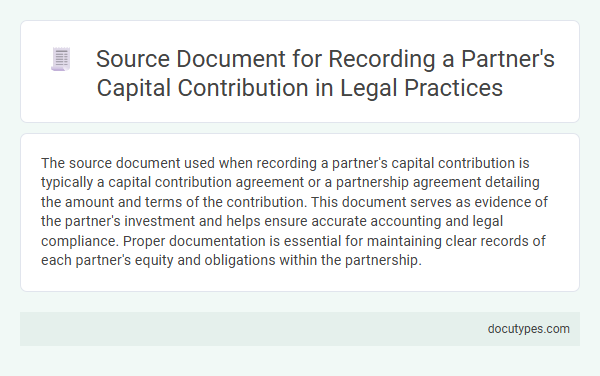The source document used when recording a partner's capital contribution is typically a capital contribution agreement or a partnership agreement detailing the amount and terms of the contribution. This document serves as evidence of the partner's investment and helps ensure accurate accounting and legal compliance. Proper documentation is essential for maintaining clear records of each partner's equity and obligations within the partnership.
Introduction to Source Documents in Legal Practices
In legal practices, source documents serve as the foundational evidence for financial transactions. When recording a partner's capital contribution, these documents provide verifiable proof of the transaction's legitimacy and details.
The primary source document used is the partnership agreement or a capital contribution agreement. These documents outline the terms, amount, and form of the partner's contribution, ensuring accurate and lawful record-keeping.
Importance of Accurate Capital Contribution Records
The primary source document used when recording a partner's capital contribution is the capital contribution agreement or capital contribution statement. This document details the amount and nature of the assets or cash contributed by the partner, serving as official evidence for accounting and legal purposes. Accurate capital contribution records are crucial for ensuring transparency, maintaining equitable ownership interests, and facilitating dispute resolution among partners.
Types of Source Documents for Capital Contributions
| Types of Source Documents for Partner's Capital Contribution | |
|---|---|
| 1. Bank Deposit Slips | Proof of cash contributions deposited into the partnership's bank account. Essential for verifying and recording monetary capital inputs. |
| 2. Property Deed or Title | Used when a partner contributes real estate or tangible property. Establishes legal ownership transfer to the partnership. |
| 3. Bills of Sale | Documents sales or transfers of tangible assets like equipment or inventory to the partnership from the partner. |
| 4. Promissory Notes | Represents loans or receivables contributed as capital. Records the obligation and amount agreed upon by the partner. |
| 5. Contribution Agreements | Written agreements detailing the nature, value, and terms of the partner's contribution. Serves as official record for accounting and legal purposes. |
| 6. Stock Certificates or Investment Statements | Used when partners contribute shares or investments from other entities. Validates ownership stakes transferred to the partnership. |
Legal Requirements for Recording Partner Contributions
When recording a partner's capital contribution, the primary source document used is the Capital Contribution Agreement. This legal document outlines the amount, form, and terms of the contribution made by the partner to the partnership.
It is essential to comply with state partnership laws and the partnership agreement to accurately record these contributions. Proper documentation ensures clarity in ownership percentages and protects the rights of all partners under the law.
Elements of a Valid Source Document
A valid source document used when recording a partner's capital contribution is typically a capital contribution agreement or a deposit receipt. These documents must clearly state the date, the amount or value of the contribution, and the identities of the contributing partner and the partnership. Accurate documentation ensures legal compliance and provides an auditable record of the transaction.
Procedures for Documenting Partner Capital Inflows
When recording a partner's capital contribution, the primary source document used is the capital contribution agreement. This document outlines the specific amount and nature of the assets contributed by the partner to the partnership.
You must ensure proper documentation of partner capital inflows through signed agreements and transaction receipts. Procedures include verifying the contribution amount, noting the date, and detailing the form of contribution, whether cash, property, or services. Accurate records maintain transparency and support legal compliance within the partnership's financial reporting.
Common Challenges in Recording Capital Contributions
When recording a partner's capital contribution, the primary source document is the partnership agreement or the capital contribution agreement. These documents detail the amount and nature of the contribution, serving as the official record for bookkeeping and legal purposes.
Common challenges in recording capital contributions include accurately valuing non-cash assets, ensuring proper documentation is maintained, and correctly allocating contributions among partners.
- Valuation Difficulties - Non-cash contributions like property or equipment require precise fair market value assessments to prevent disputes.
- Documentation Gaps - Missing or incomplete agreements can lead to misunderstandings and incorrect capital account balances.
- Allocation Errors - Incorrectly assigning contribution amounts among partners may cause imbalance in ownership percentages and profit sharing.
Recommendations for Legal Compliance and Best Practices
What source document is used when recording a partner's capital contribution? The primary source document is the capital contribution agreement, which outlines the terms and amount of the partner's investment. Maintaining a signed and detailed agreement ensures legal compliance and accurate financial records for the partnership.
How can partnerships ensure legal compliance when recording capital contributions? It is recommended to retain all original documentation, including signed agreements and payment proofs, to support the contribution entry. Clear record-keeping enhances transparency and protects the partnership during audits or legal reviews.
Role of Source Documents in Dispute Resolution
Source documents play a crucial role in accurately recording a partner's capital contribution in legal and accounting contexts. Your ability to resolve disputes often depends on the clarity and authenticity of these original records.
- Capital Contribution Agreement - This document outlines the terms and amount of the partner's capital investment, serving as primary evidence of the transaction.
- Bank Deposit Slips - These slips confirm the actual transfer of funds into the partnership's account, verifying the contribution's validity.
- Share Certificates or Equity Records - These formalize ownership shares issued to the partner, reflecting their equity stake in the partnership.
What Source Document Is Used When Recording a Partner’s Capital Contribution? Infographic

